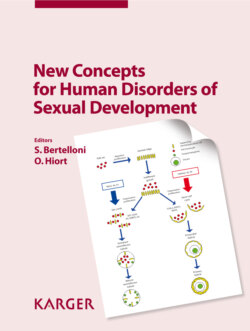Читать книгу New Concepts for Human Disorders of Sexual Development - Группа авторов - Страница 33
На сайте Литреса книга снята с продажи.
Pubertal Activation of the Testis
ОглавлениеStart of puberty is defined by an increase of the testicular volume to >3ml, which is due to onset of spermatogenesis and production of large numbers of post-meiotic germ cells. Initially before this is evident, the number of mature Leydig cells increase and become activated, indicating that precursor cells (e.g. peritubular-like Leydig stem cells and perivascular cells) are being recruited for this purpose [Chemes et al., 1985, 1992; Cigorraga et al, 1994]. These peritubular-like Leydig stem cells express platelet-derived growth factor receptor-α but not the LH receptor or steroidogenic enzymes [Ge et al., 2006]. After experimental ablation of Leydig cells with selective toxicants, peritubular spindle-shaped cells act as precursors of Leydig cells [Jackson et al., 1986; Teerds et al., 1988]. These peritubular cells are myoid in nature and express α-actin at high levels, which can be used for their identification. Although such testicular cells are considered to be the immediate source of Leydig cells in postnatal humans, perivascular cells of the interstitial tissue, testicular macrophages and neural crest cells have also been proposed as precursor Leydig cells [Jackson et al., 1986; Schulze et al., 1987; Teerds et al., 1988]. The latter suggestion is based on several findings that human Leydig cells express a number of proteins typical for cells of neuronal origin. INSL3 not only controls the early phase of testicular descent during embryonic development, but is also expressed and secreted by adult-type human Leydig cells [Foresta et al., 2004]. Recently, the INSL3 concentration in the peripheral blood of men has been shown to decline continuously in a linear fashion between the ages of 35 and 80 years; a phenomenon that probably reflects a reduction in Leydig cell functionality with age [Anand-Ivell et al., 2006]. In contrast, onset of puberty in boys is associated with a significant rise in INSL3 levels [Wikstrom et al., 2006].
